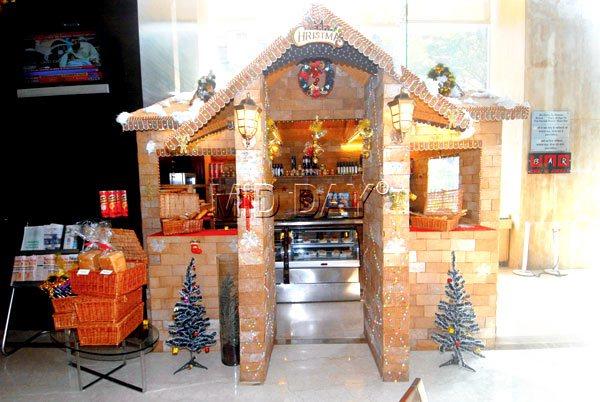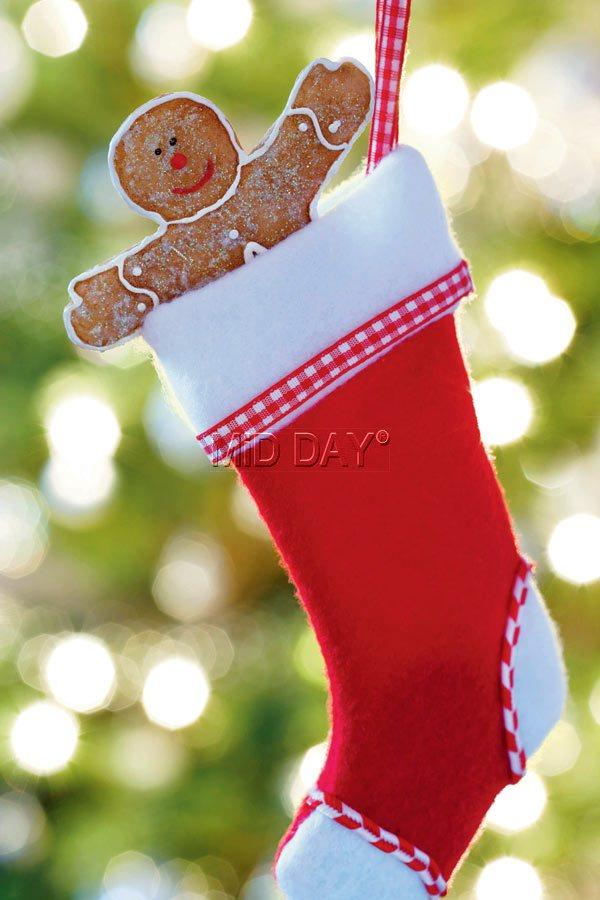Be it in the shape of a house or a man, Christmas sets the mood to bake warm, spiced gingerbread cakes or cookies, all laden with cinnamon, star anise, nutmeg, white pepper, cloves and ginger. Phorum Dalal finds out why the festival is incomplete without them

Once upon a time, two children named Hansel and Gretel, who were left in the woods by their father and stepmother,
stumbled upon a house made of gingerbread and cakes...”
ADVERTISEMENT
Every time we heard this story as a child, we pictured those edible caramel-brown walls, the windows made of candy and roof made of cookies. As adults too, this fantasy never really leaves us, with the tradition of gingerbread houses made especially during Christmas.

A gingerbread (below) and cookie house at Ramada Powai Hotel and Convention Centre. Pic/Sameer Markande
While hotels across the city, including Sofitel at Bandra Kurla Complex, and Ramada Powai Hotel and Convention
Centre, have created their very own versions of the edible houses, bakers and chocolatiers across the city have created their own gingerbread versions, along with cookies and sweets, for the festive season.
Legend of gingerbread
Any confection made with honey, spices and preserved ginger is called gingerbread. There are various versions around the world such as French Spice Bread, which is drier and made of honey or treacle and German Pfefferkuchen (which means pepper cake). In England, they are made in the form of cakes, cookies and biscuits, especially in the shape of the gingerbread man whose origin leads to two interesting stories. One is the fairytale in which a gingerbread man comes alive and outruns an elderly couple and farm animals. Eventually, a fox eats him up. In the more believable tale, it is said Queen Elizabeth I served gingerbread to foreign dignitaries.
In Netherlands and Belgium, the soft and crumbly gingerbread called Peperkoek is a breakfast delicacy, while in the
Nordic countries, the gingerbread is usually a thin, brittle cookie. In Switzerland, the gingerbread cake, commonly called biber, is stuffed with marzipan filling.

Chef and founder of La Folie at Kala Ghoda, Sanjana Patel says, “According to sugar-craft scholar Steven Stellingwerf, gingerbread was introduced to Western Europe by 11th-century crusaders returning from the eastern Mediterranean. The term is now broadly used to describe any type of sweet treat that combines ginger with honey, treacle or molasses, which is uncrystallised syrup made during the refining of sugar. Christmas goodies generally
contain cinnamon, cardamom, star anise, nutmeg, white pepper, pepper, cloves and ginger as they help keep the
human body warm.” This year, Patel’s menu includes German Stollen bread with cranberries, raisins and rum, gingerbread cookies and caramel shots.
Christmas food is all about earthy flavours that warm you up, says owner of Juhu-based Onesta confectionary, Neha
Choudhury, whose menu offers Ginger cookies, White Chocolate Raspberry brownies that resemble the festive colours and Milk Chocolate and Orange Spiced Mousse. “I have also come up with Cinnamon and Caramel Popcorn to add a contemporary twist to Christmas sweets. Over the world, Christmas cooking involves using ingredients that are available at that time of the year — that is why usually dried fruits, raisins, candied fruits and mulled wine are used,”
says Choudhury.
Indian version
Gurgaon-based Deeba Rajpal, has created her own ‘Indianised’ version of the gingerbread. “I make it with whole wheat and add jaggery instead of sugar. My first memory of the gingerbread man is the board game candyland, which had pastel-coloured gingermen,” says the home baker, who has her own blog called Passionate About Baking.
Reshma Mane, who runs a catering business called Every Aroma Caterers, keeps in mind the Indian palate while baking the goodies. “Ginger has a very strong taste. Since most Indians have a sweet tooth, I have made some innovations to the gingerbread cookies and added lemon zest, chocolate and honey. With the nip in the air, these are perfect with a cup of chai.”
 Subscribe today by clicking the link and stay updated with the latest news!" Click here!
Subscribe today by clicking the link and stay updated with the latest news!" Click here!






